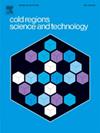Estimating equivalent elastic properties of frozen clay soils using an XFEM-based computational homogenization
Abstract
This study addresses the challenge of estimating the elastic properties of heterogeneous frozen clay soils by introducing a comprehensive approach that combines analytical and numerical models. The frozen clay soil is treated as a mixture composed of frozen clay-water composites and nonclay mineral inclusions. An inversion algorithm is employed to deduce the elastic properties of the matrix (clay-water composites) of two artificially frozen sandy clay samples with known temperature-dependent elastic properties. Subsequently, a two-dimensional numerical simulation using the eXtended Finite Element Method (XFEM) is conducted to carry out numerical homogenization by considering the imperfect bond among frozen clay-water composites and nonclay minerals. The numerical homogenization model offers insights into the temperature-dependent behavior of the interface stiffness parameter. The numerical homogenization results are compared with conventional numerical homogenization approaches like the FEM, which rigidly defines the bonding between inclusions and the matrix. The comparison indicates that the neglect of imperfect bonds among clay-water composites and nonclay minerals will lead to unrealistic outcomes in cases with a high fraction of inclusions. This integrated approach advances the understanding and prediction of elastic properties of frozen clay soils by considering their heterogeneous nature.

 求助内容:
求助内容: 应助结果提醒方式:
应助结果提醒方式:


